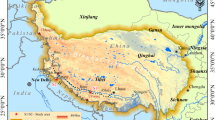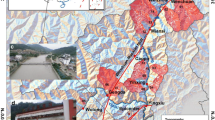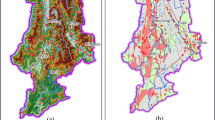Abstract
The occurrence of debris flow from channel-bed failure is occasionally noted in small and steeply sloping watersheds where channelized water flow dominates debris flow initiation. On August 12, 2016, a debris flow from channel-bed failures occurred in the Caozhuangzi Watershed of the Longtan Basin, Miyun, Beijing. Rainfall records over 10-min intervals and field investigations including channel morphology measurements were used to study the triggering conditions and erosion process. The results indicated that the occurrence of this event lagged the peak 10-min rainfall interval and that the cumulative rainfall prior to the occurrence time played an important role in its formation. A mean 10-min rainfall intensity–duration expression in the form of I10 = 5.0 × D−0.21, where I10 denotes the mean 10-min rainfall intensity and D is the rainfall duration ranging from 10 to 60 h, was proposed. The debris flows have low proportions of grain size fractions < 0.1 mm and higher fractions of grains 0.1–2 mm in size, indicating that the flow had low viscosity and was coarse-grain dominated. Channel morphology analysis revealed that abrupt changes in topography in the study area, including a steep section, a concave stream bank area, and a partial concave stream section were eroded more extensively than other sites. The maximum sediment erosion volume and erosion depth were not proportional to the variation in stream gradient. Consideration of the degree of erosion in the channel at sites with abrupt morphology changes, the maximum sediment erosion volume, and the erosion depth and volume at the initial channel site and downstream region of forest area together showed that the prime factor controlling erosion was entrained sediment volume. This work, thus, provides a case study regarding the triggering conditions of runoff-triggered debris flows and the topographical changes by debris flow erosion.













Similar content being viewed by others
References
Beijing Water authority (1999) Beijing hydrology handbook, (Unpublished in Chinese)
Berti M, Simoni A (2005) Experimental evidences and numerical modelling of debris flow initiated by channel runoff. Landslides 2(3):171–182
Breien H, Blasio FVD, Elverhøi A, Høeg K (2008) Erosion and morphology of a debris flow caused by a glacial lake outburst flood, western Norway. Landslides 5(3):271–280
Cannon SH, Gartner JE, Wilson RC, Bowers JC, Laber JL (2008) Storm rainfall conditions for floods and debris flows from recently burned areas in southwestern Colorado and southern California. Geomorphology 96(3):250–269
Coe JA, Kinner DA, Godt JW (2008) Initiation conditions for debris flows generated by runoff at Chalk Cliffs, central Colorado. Geomorphology 96(3):270–297
Comiti F, Marchi L, Macconi P, Arattano M, Bertoldi G, Borga M, Brardinoni F, Cavalli M, D’Agostino VD, Penna D, Theule J (2014) A new monitoring station for debris flows in the European Alps: first observations in the Gadria basin. Nat Hazards 73(3):1175–1198
Cui P, Guo XJ, Zhuang JQ (2014) Determination of the runoff threshold for triggering debris flows in the area affected by the Wenchuan earthquake. Nat Hazards Earth Syst Sci Discuss 2(7):4659–4684
Cuomo S, Sala MD (2013) Rainfall-induced infiltration, runoff and failure in steep unsaturated shallow soil deposits. Eng Geol 162(14):118–127
Cuomo S, Sala MD, Novità A (2015) Physically based modelling of soil erosion induced by rainfall in small mountain basins. Geomorphology 243:106–115
Egashira S, Honda N, Itoh T (2001) Experimental study on the entrainment of bed material into debris flow. Phys Chem Earth Part C 26(9):645–650
Fei X, Su A (2004) Movement mechanism and disaster control for debris flow. Press of Tsinghua University, Beijing, pp 49–61 (in Chinese)
Gabet EJ, Mudd SM (2006) The mobilization of debris flows from shallow landslides. Geomorphology 74(1–4):207–218
Godt JW, Coe JA (2007) Alpine debris flows triggered by a 28 July 1999 thunderstorm in the central front range, Colorado. Geomorphology 84(1):80–97
Gregoretti C, Fontana GD (2008) The triggering of debris flow due to channel-bed failure in some alpine headwater basins of the dolomites: analyses of critical runoff. Hydrol Process 22(13):2248–2263
Guo XJ, Cui P, Li Y (2013) Debris flow warning threshold based on antecedent rainfall: a case study in Jiangjia Ravine, Yunnan, China. J Mt Sci 10(2):305–314
Guo X, Cui P, Li Y, Ma L, Ge Y, Mahoney WB (2016) Intensity–duration threshold of rainfall-triggered debris flows in the Wenchuan earthquake affected area, China. Geomorphology 253:208–216
Hu KH, Wei FQ, Li Y (2011) Real-time measurement and preliminary analysis of debris-flow impact force at Jiangjia Ravine, China. Earth Surf Process Landf 36(9):1268–1278
Hungr O, Morgan GC, Kellerhals R (1984) Quantitative analysis of debris torrent hazards for design of remedial. Can Geotech J 21(4):663–677
Hungr O, Mcdougall S, Bovis M (2005) Entrainment of material by debris flows. Springer Praxis Books, pp 135–158
Iverson RM (1997) The physics of debris flow. Rev Geophys 35(3):245–296
Iverson RM, Ouyang C (2015) Entrainment of bed material by earth-surface mass flows: review and reformulation of depth-integrated theory. Rev Geophys 53(1):27–58
Iverson RM, Reid ME, Logan M, Lahusen RG, Godt JW, Griswold JP (2011) Positive feedback and momentum growth during debris-flow entrainment of wet bed sediment. Nat Geosci 4(2):116–121
Kang ZC, Cui P, Wei FQ, He SF (2006) Observed dataset of Dongchuan debris flow observation and research station, Chinese Academy of Science (1961-1984). Science press, Beijing (in Chinese)
Kean JW, Mccoy SW, Tucker GE, Staley DM, Coe JA (2013) Runoff-generated debris flows: observations and modeling of surge initiation, magnitude, and frequency. J Geophys Res Earth Surf 118(4):2190–2207
Kean JW, Coe JA, Coviello V, Smith JB, Mccoy SW, Arattano M (2015) Estimating rates of debris flow entrainment from ground vibrations. Geophys Res Lett 42(15):6365–6372
Li JH, Yu XX, Xie BY, Gao JR (2007) Debris flows and floods in mountain regions near Beijing. China Forestry Publishing House, Beijing (in Chinese)
Li P, Hu K, Wang X (2017a) Debris flow entrainment rates in non-uniform channels with convex and concave slopes. J Hydraul Res 8:1–12
Li Y, Ma C, Wang Y (2017b) Landslides and debris flows caused by an extreme rainstorm on 21 July 2012 in mountains near Beijing, China. Bull Eng Geol Environ 3:1–16
Ma C, Wang YJ, Du C, Wang YQ, Li YP (2016) Variation in initiation condition of debris flows in the mountain regions surrounding Beijing. Geomorphology 273:323–334
Ma C, Wang Y, Hu K, Du C, Yang W (2017) Rainfall intensity–duration threshold and erosion competence of debris flows in four areas affected by the 2008 Wenchuan earthquake. Geomorphology 282:85–95
Marchi L, Arattano M, Deganutti AM (2002) Ten years of debris-flow monitoring in the Moscardo Torrent (Italian Alps). Geomorphology 46(1–2):1–17
McCoy SW, Kean JW, Coe JA, Tucker GE, Staley DM, Wasklewicz TA (2012) Sediment entrainment by debris flows: in situ measurements from the headwaters of a steep catchment. J Geophys Res Earth Surf 117(F3):F03016
Navratil O, Liébault F, Bellot H, Travaglini E, Theule J, Chambon G (2013) High-frequency monitoring of debris-flow propagation along the Réal Torrent, southern French Prealps. Geomorphology 201:157–171
O’Connor J E, Hardison J H, Costa J E (2001) Debris flows from failures of Neoglacial-age moraine dams in the three sisters and Mount Jefferson Wilderness areas, Oregon. Geological Survey professional paper, 1606: 1044–9612
Papa M, Egashira S, Itoh T (2004) Critical conditions of bed sediment entrainment due to debris flow. Nat Hazards Earth Syst Sci 4(3):469–474
Santi PM, Dewolfe VG, Higgins JD, Cannon SH, Gartner JE (2008) Sources of debris flow material in burned areas. Geomorphology 96(3):310–321
Takahashi T (2014) Debris flow: mechanics, prediction and countermeasures. Taylor & Francis
Tang C, Zhu J, Li WL, Liang JT (2009) Rainfall-triggered debris flows following the Wenchuan earthquake. Bull Eng Geol Environ 68(2):187–194
Tang C, Zhu J, Ding J, Cui XF, Chen L, Zhang JS (2011) Catastrophic debris flows triggered by a 14 August 2010 rainfall at the epicenter of the Wenchuan earthquake. Landslides 8(4):485–497
Tang C, Asch TWJV, Chang M, Chen GQ, Zhao XH, Huang XC (2012) Catastrophic debris flows on 13 august 2010 in the Qingping area, southwestern China: the combined effects of a strong earthquake and subsequent rainstorms. Geomorphology 139–140(2):559–576
Theule JI, Liébault F, Loye A, Laigle D, Jaboyedoff M (2015) Channel scour and fill by debris flows and bedload transport. Geomorphology 243:92–105
Tian M, Hu KH, Ma C, Lei FH (2014) Effect of bed sediment entrainment on debris-flow resistance. J Hydraul Eng 140(1):115–120
Tognacca C, Bezzola GR, Minor HE (2000) Threshold criterion for debris-flow initiation due to channel-bed failure. In: Proceedings of the 2nd International Conference on Debris Flow Hazard Mitigation: Mechanics, Prediction and Assessment, Taipei, Taiwan, 16–18 Aug 2000. Balkema, Rotterdam, pp 89–97
Tu J, Ma C, Yang HL (2017) Rainfall condition of triggering debris flows in Beijing mountain regions. Sci Soil Water Conserv 15(5):103–110 (in Chinese)
Wang G, Sassa K (2003) Pore-pressure generation and movement of rainfall-induced landslides: effects of grain size and fine-particle content. Eng Geol 69(1–2):109–125
Wang G, Sassa K, Fukuoka H (2003) Downslope volume enlargement of a debris slide–debris flow in the 1999 Hiroshima, Japan, rainstorm. Eng Geol 69(3–4):309–330
Wieczorek GF, Glade T (2005) Climatic factors influencing occurrence of debris flows. In: Debris-flow hazards and related phenomena. Springer Berlin Heidelberg
Zhong DL, Xie H, Wang SG, Wei FQ, Ji HC, Liu SJ, Tang JF, Yang JH (2004) Debris flows in mountain regions near Beijing. The Commercial Press, Beijing (in Chinese)
Zhou W, Tang C (2014) Rainfall thresholds for debris flow initiation in the Wenchuan earthquake-stricken area, southwestern China. Landslides 11(5):877–887
Acknowledgements
The authors acknowledge the anonymous reviewers of this paper for their detailed remarks and helpful suggestions.
Funding
This study was supported by the Fundamental Research Funds for the Central Universities (grant No. 2016ZCQ06) and the National Natural Science Foundation of China (No. 41702369).
Author information
Authors and Affiliations
Corresponding author
Rights and permissions
About this article
Cite this article
Ma, C., Deng, J. & Wang, R. Analysis of the triggering conditions and erosion of a runoff-triggered debris flow in Miyun County, Beijing, China. Landslides 15, 2475–2485 (2018). https://doi.org/10.1007/s10346-018-1080-3
Received:
Accepted:
Published:
Issue Date:
DOI: https://doi.org/10.1007/s10346-018-1080-3




